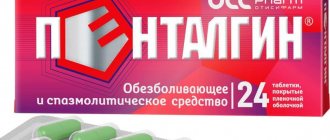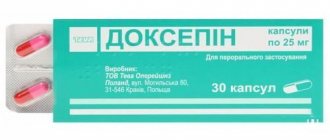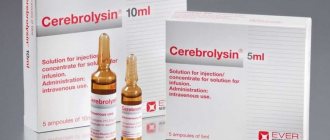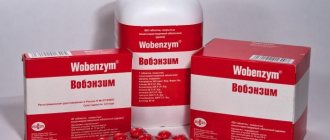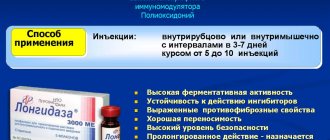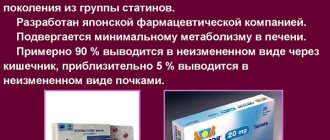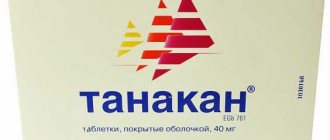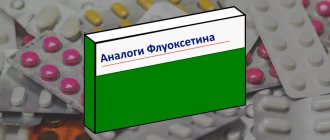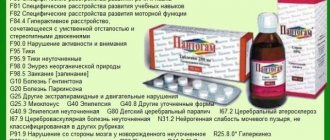There are restrictions during pregnancy
Has restrictions when breastfeeding
Has restrictions for children
Prohibited for use if you have kidney problems
The drug Pantogam is a nootropic drug that is prescribed to restore brain activity, increase mnestic functions and mental activity. This is a medication based on the active component hopantenate. The medicine is produced by a domestic pharmaceutical company.
Packaging of the medicine Pantogam
The medicine is prescribed to adult patients as part of complex treatment in the presence of the following indications:
- brain damage due to injury or infection, which is accompanied by deterioration of cognitive functions;
- extrapyramidal disorders (including parkinsonism);
- epilepsy and seizures;
- psycho-emotional or physical overload;
- urinary dysfunction of neurogenic origin.
The medication can also be prescribed to children over 3 years of age who have mental retardation, cerebral palsy, hyperactivity, stuttering or nervous tics. The medicine is not used in cases of individual intolerance to its components and impaired renal function.
The drug Pantogam has both structural analogues, which contain the same active substance, and substitutes with a similar effect on the body.
Compound
INN (international nonproprietary name) is hopantenic acid.
Pantogam tablets
1 tablet contains 250 mg or 500 mg of hopantenic acid - the active substance.
Auxiliary ingredients according to the mass content of the active substance:
- 3.1 mg or 6.2 mg - calcium stearate;
- 0.8 mg or 1.6 mg - methylcellulose;
- 9.3 mg or 18.6 mg - talc;
- 46.8 mg / 93.6 mg - magnesium hydroxycarbonate.
Pantogam syrup
1 bottle contains 10 g/100 ml of hopantenic acid - the active substance.
Auxiliary ingredients:
- 15 g - sorbitol;
- 25.8 g - glycerol;
- 0.1 g - citric acid monohydrate;
- 0.05 g - aspartame;
- 0.1 g – sodium benzoate;
- 0.01 g — food flavoring “Cherry 667”;
- up to 100 ml - purified water.
Gopantham or Pantogam
Gopantam is a domestic analogue of Pantogam in tablets. Differs in price up to 1.5 times lower. Available in dosages of 250 and 500 mg.
In other respects, Pantogam and the Gopantam analogue are similar: active substance, tablet dosage, properties, indications, limitations, side effects. If it is impossible to buy an expensive medicine, you can choose a cheap substitute.
Pharmacodynamics and pharmacokinetics
the neurotransmitter GABA in its structure . Directly affects the GABA (subtype B) receptor-channel complex. Shows anticonvulsant and nootropic activity, increases the brain's resistance to toxic effects and hypoxia. In neurons, it activates anabolic processes, reduces motor excitability, stimulates physical performance and mental activity of the body, combines moderate sedative effects with a mild stimulating effect.
In cases of chronic alcohol intoxication, as well as in cases of alcohol abstinence, it improves the metabolism of GABA. Shows the ability to inhibit acetylation reactions , which take part in the mechanism of inactivation of sulfonamides and procaine (Novocaine) , as a result of which their action is prolonged. Prevents the pathological increase in the bladder reflex and increased detrusor tone.
When taken orally hopantenic acid is quickly absorbed from the gastrointestinal tract, has the ability to pass through the blood-brain barrier , and creates the highest concentrations in the walls of the stomach, liver, skin and kidneys.
It cannot be metabolized and is excreted unchanged within 2 days. 28.5% of the drug is excreted in feces and 67.5% in urine.
Pantogam or Phenibut
Phenibut (Anvifen) is a strictly prescription analogue of Pantogam, which has a psychostimulating and nootropic effect and is an antidepressant. Available in tablets, it is prescribed for sleep disorders, urination problems, stuttering, neuroses, and alcohol withdrawal syndrome. In children's practice it is used from the age of 8.
Buyers are interested in the question of what is the difference between Phenibut or Pantogam. Both medications are nootropics with different mechanisms of action. The indications differ - the first medicine is used mainly for the elderly. The second is actively prescribed to children of the first year of life and older, patients after a stroke, and with organic brain lesions.
Indications for use Pantogam
Indications for the use of Pantogam tablets for adult patients and children starting from 3 years of age:
- cognitive impairment in neurotic disorders , as well as due to organic brain damage (including traumatic brain injury and the consequences of neuroinfections);
- extrapyramidal pathologies (hepatolenticular degeneration, parkinsonism, myoclonus epilepsy, Huntington's chorea, etc. ) ;
- cerebrovascular insufficiency , provoked by atherosclerotic abnormalities in the vascular structure of the brain ;
- prevention, as well as treatment of extrapyramidal syndrome (akinetic, hyperkinetic), due to taking antipsychotics;
- epilepsy occurring with inhibition of mental processes (prescribed in combination with anticonvulsant drugs);
- psycho-emotional excessive stress, decreased physical performance and mental activity, in order to improve memory and concentration;
- neurogenic changes in the process of urination (enuresis, frequent urination, urge incontinence, urgency);
- organic cerebral insufficiency in schizophrenia;
- Children over 3 years of age are prescribed Pantogam tablets for perinatal encephalopathy, mental retardation of varying severity, delayed motor, speech, mental development, or a combination thereof. Also for various forms of cerebral palsy, neurosis-like pathologies (tics, stuttering) , hyperkinetic manifestations (hyperactivity syndrome with observed attention deficit).
Indications for use of Pantogam for children from birth, in the form of syrup:
- perinatal encephalopathy (prescribed from birth);
- Cerebral palsy of varying severity;
- mental retardation of varying severity, including behavioral disorders;
- pathologies of psychological status (delayed mental or physical development, specific pathologies of motor functions, speech, as well as their combination);
- development of school skills in children (writing, reading, counting, etc.);
- senile dementia in its initial forms;
- hyperkinetic abnormalities, including attention deficit hyperactivity disorder;
- decreased mnestic-intellectual activity due to arteriosclerotic pathologies of cerebral vessels;
- trauma, toxic or neuroinfectious effects on the brain;
- neurosis-like conditions ( stuttering, inorganic encopresis , tics);
- cerebral organic pathology in schizophrenia (in combination with psychotropic drugs);
- extrapyramidal diseases ( Parkinson's disease , Huntington's syndrome , hepatolenticular degeneration, myoclonus epilepsy, etc.);
- therapy and prevention of extrapyramidal syndrome due to taking antipsychotics;
- decreased performance, both physical and mental, psycho-emotional overload, in order to improve memory and concentration;
- epilepsy with inhibition of mental processes and decreased cognitive productivity (in combination with anticonvulsants);
- urinary disorders of neurogenic etiology.
Pantogam or Picamilon - which is better?
Picamilon is a domestic nootropic in injections and tablets based on aminobutyric acid ester. The analogue dilates blood vessels in the brain, prevents frequent migraine attacks, normalizes cerebral circulation and metabolism, improves memory, attention, mental abilities and performance. Reduces anxiety, fear, irritability and other signs of neurotic disorders.
Picamilon and Pantogam differ in properties, age restrictions, and indications. Prescribed by a doctor: the first from 3 years, the second can be from the first day of life.
Contraindications
The leaflet for the drug Pantogam indicates the following contraindications to its use.
For tablets:
- patient age under 3 years;
- breastfeeding period ;
- pregnancy period .
For the syrup:
- first trimester of pregnancy;
- phenylketonuria , due to the content of aspartame in the syrup.
Are common:
- hypersensitivity to hopantenic acid or other ingredients of the syrup or tablets;
- acute kidney pathologies in severe form.
Pantogam asset - analogues
Pantogam active is a new capsule form containing 200 and 300 mg of the active substance (hopantenic acid) and isomer. Used to treat cognitive disorders, epilepsy, urinary disorders, and brain damage. It has not been clinically tested for use in children, so the age limit is up to 18 years.
Analogs of the drug Pantogam active are the same as the regular form.
Buyers are interested in what is better – Pantogam or Pantogam asset? For adults, any form can be prescribed. For children, Pantogam in tablets or syrup is better. In terms of their effect, the drugs are identical.
Side effects
As a rule, therapy using Pantogam occurs without serious complications.
Sometimes side effects in the form of allergic reactions (rashes on the skin, conjunctivitis, rhinitis) . In this case, reduce the dose of Pantogam or cancel therapy with its use.
Also, noise in the head, sleep phase disturbances or daytime sleepiness were observed. These symptoms usually do not require discontinuation of treatment and are short-lived.
Cases of overdose and side effects
If you mistakenly take a larger amount of the drug, an increase in adverse reactions occurs: drowsiness, insomnia, noise in the head and headache.
You should perform a gastric lavage, drink activated charcoal or Smecta. Treat symptoms as needed. An overdose occurs when an increased dose of medication is taken by mistake; this indicator is individual for each person.
Side effects from taking Pantogam include allergic manifestations:
- rhinitis;
- conjunctivitis;
- skin rashes.
To eliminate them, a dose reduction or complete discontinuation of the drug is required. Insomnia or drowsiness, noise and pain in the head often occur. There is no need to cancel treatment - this is a short-term phenomenon.
Instructions for use Pantogam (Method and dosage)
The medicine Pantogam in the form of syrup and tablets is prescribed orally after meals, after 15–30 minutes.
The preferred appointment time is before 16:00.
Pantogam tablets, instructions for use
The recommended single dose of Pantogam in the form of tablets for adult patients is 250 mg - 1000 mg, the daily dosage is 1500 mg - 3000 mg.
Children from 3 years of age are prescribed tablets in a single dose ranging from 250 mg to 500 mg, the daily dosage is 750 mg - 3000 mg.
The course of therapy usually takes from 30 to 120 days, in some cases up to six months. After a 3 or 6 month break, you can repeat the course of treatment.
For combination therapy of epilepsy , Pantogam is prescribed in a daily dose of 750 mg - 1000 mg, for a year or more.
In the combined treatment of extrapyramidal neuroleptic syndrome , up to 3 g of the drug is taken over several months.
When conducting combination therapy of extrapyramidal hyperkinesis in patients with hereditary pathological conditions of the nervous system , a daily dose of 500 mg to 3000 mg is recommended for up to 4 months or even more.
To neutralize the consequences of head injury and neuroinfections - 0.25 g (250 mg) of Pantogam, taken 3 - 4 times a day.
To restore performance in conditions of asthenia and excessive stress - 3 times a day, 250 mg.
For the treatment of extrapyramidal syndrome , due to the use of antipsychotics , it is recommended for adult patients 500 mg - 1000 mg, three times a day; for children, the recommended dosage is from 250 mg to 500 mg in 3-4 doses. Treatment lasts from 1 to 3 months.
Children with tics are prescribed 3-6 doses per day at a dose of 250 mg to 500 mg, for 1 to 4 months.
For problems with urination, adult patients take Pantogam tablets 2-3 times a day, 500 mg - 1000 mg; pediatric patients: 250 mg - 500 mg (the recommended daily dose varies from 25 mg to 50 mg per kilogram of weight). The course of therapy is carried out over 1 to 3 months.
Depending on age, children with various diseases of the nervous system are prescribed from 1 to 3 g of Pantogam.
The dosage regimen most often boils down to increasing the dose over 7–12 days, followed by taking the maximum dose of Pantogam for 15–40 days, with a slow decrease in the maximum dose (7–8 days) until the drug is completely discontinued.
If a repeated course of therapy is necessary, the break should be from 1 to 3 months.
Pantogam syrup, instructions for use
Adult patients are prescribed a single dose of 2.5 ml - 10 ml, the daily dosage is 15 ml - 30 ml.
For children from 0 months, a single dose of 2.5 ml - 5 ml is recommended, the daily dosage is 7.5 ml - 30 ml.
Therapy is carried out for 1 to 4 months, less often up to 6 months. Re-prescribing Pantogam is possible after a break of 3-6 months.
The recommended range of daily doses for children, depending on pathology and age, is:
- from 0 to 12 months – 5 ml – 10 ml;
- up to 3 years – 5 ml – 12.5 ml;
- from 3 to 7 years – 7.5 ml – 15 ml;
- over 7 years old – 10 ml – 20 ml.
Treatment tactics recommend increasing the daily dose over 7–12 days, followed by taking the maximum dose for 15–40 or more days with a gradual dose reduction (7–8 days) until the drug is discontinued . The course of therapy ranges from 30 to 90 days (for the treatment of some diseases up to 6 months or even more).
For combination therapy of epilepsy with parallel administration of anticonvulsants , 7.5 ml - 10 ml per day is prescribed. Treatment lasts for 12 months or more.
For the combined treatment of schizophrenia with the joint use of psychotropic drugs, 5 ml - 30 ml per day is recommended, with a course of treatment from 30 days to 3 months.
When treating neuroleptic syndrome , with concomitant extrapyramidal disorders, take a daily dose of the drug of up to 30 ml of syrup. Therapy is carried out over several months.
When treating the consequences of head injury and neuroinfections, a daily dosage of 5 ml to 30 ml is prescribed.
For extrapyramidal hyperkinesis , for the treatment of patients with organic pathologies of the nervous system , a daily dose of syrup from 5 ml to 30 ml is recommended. The course of therapy is up to 4 months or more.
The syrup is taken in order to restore performance during asthenia and excessive stress three times a day in a dose of 2.5 ml - 5 ml.
Children with urinary disorders are prescribed 2.5 ml - 5 ml, with a daily dose equal to 0.25 ml - 0.5 ml per kilogram of weight. The course of therapy lasts from 30 days to 3 months; for adults, it is recommended to take syrup 2-3 times a day, 5 ml - 10 ml.
When carrying out long-term therapy, parallel administration of drugs with identical effects is not recommended.
Interaction
Pantogam, when taken in combination with barbiturates , prolongs their action.
When used together with anticonvulsants, it enhances their effectiveness.
Prevents the side effects of Carbamazepine, Phenobarbital, and neuroleptics.
Potentiates the effects of drugs for local anesthesia (Procaine).
The effect of Pantogam is enhanced by complex treatment with etidronic acid and Glycine.
Pantogam's analogs
Level 4 ATX code matches:
Bravinton
Acefen
Carnicetine
Pyracesin
Nooclerin
Semax
Piracetam
Olatropil
Fezam
Vinpocetine
Cerebrocurin
Cavinton Forte
Calcium hopantenate
Glutamic acid
Cephabol
Olanzapine
Cerebrolysate
Pramistar
Sidnocarb
Vinpotropil
When looking for alternative medicines, you may be offered the following Pantogam analogues:
- Vinpocetine;
- Ginkgo biloba;
- Glycine;
- Cavinton;
- Lutsetam;
- Cortexin;
- Nootropil;
- Piracetam;
- Cerebrolysin;
- Thiocetam;
- Encephabol and many others.
For children
Pantogam for children in the form of tablets is used only upon reaching the age of 3; starting from birth, you can take the drug for children in the form of syrup.
Reviews from doctors about Pantogam tablets, in the treatment of many neurological diseases in children starting from 3 years of age, are positive in 99 cases out of 100. The therapy is highly effective with minimal side effects. It is worth noting that the effect of the drug does not occur immediately, but most often, 1-1.5 months after the first dose.
Side effects of Pantogam in children are rare and most often consist of drowsiness or sleep disturbance. It is possible that these manifestations depend on the time of taking the drug, which is not recommended to be taken after 4 o’clock in the afternoon.
On user forums dedicated to drugs for the treatment of various childhood neurological pathologies, a large place is discussed about the drug Pantogam for children. Feedback from forum visitors regarding hyperactivity, stuttering , mental and physical impairments, tics , lack of attention, problems with urination, etc. mostly positive.
Let us recall that Pantogam in tablet form does not have a sufficient clinical research base, and is also physically inconvenient for infants to take, which is why Pantogam tablets are not prescribed to children under 3 years of age.
Structural analogues of the drug Pantogam
This is a rather expensive drug, but it can be replaced with drugs with an identical composition, which are both more expensive and cheaper than the original drug.
The cheapest means
The most famous cheap analogues are Cognum, Calcium hopantenate, Hopanthenic acid and Pantrotropil. They contain the same active substance - hopantanate, therefore they have the same indications, contraindications and side effects as Pantogam.
Gopantham
This product is produced in Russia by ZAO Altaivitamins. The release form of the medicine is tablets for oral administration, which contain 250 or 500 mg of calcium hopantenate. The drug has a nootropic and anticonvulsant effect.
It differs from Pantogam in manufacturer and price (it is slightly lower). Also, this product is available only in the form of tablets; it is not produced in the form of syrup or capsules.
Pantotropil
Pantotropil is a structural analogue of the drug, produced in the form of tablets for oral use. The drug is produced by Obninsk Chemical and Pharmaceutical Company CJSC (Russian Federation). No different from Pantogam, except for the manufacturer and price.
Calcium hopantenate
This product is produced by Pharmstandard-UfaVITA OJSC. The dosage form is white tablets of 250 mg of calcium hopantenate each. the action is completely identical to Pantogam.
Cognum
This is a nootropic and psychostimulant drug with identical composition, indications and contraindications. Produced in Ukraine by the private joint-stock company "Kiev Vitamin Plant".
Hopantenic acid
This product does not contain calcium salt, but directly Hopantenic acid pilyule_nervi-436 (this does not affect the properties of the medicine). 1 tablet may contain 250 or 500 mg. The drug is produced in Russia by ZAO Obninsk Chemical Physics Plant.
More expensive generic Pantocalcin
Pantocalcin is a complete analogue of Pantogam, produced domestically (JSC Valenta Pharmaceuticals). It is produced in the form of tablets, each containing 250 or 500 mg of calcium salt of hopantenic acid.
It has minor differences - slightly different excipients (for example, potato starch), and is also produced by a different pharmaceutical company. The cost of Pantocalcin is even higher - about 450 rubles for 50 tablets of 250 mg.
See also:
TOP 6 cheap Phezam analogues - structural substitutes for the drug
Newborns
The drug Pantogam for newborns can only be prescribed by an experienced pediatrician, since it is very difficult to independently notice deficiencies in the development of a child at this age.
Speaking about the effectiveness and advisability of prescribing Pantogam for newborns, reviews from parents are quite contradictory. Some are grateful to the doctors for the timely detection of a problem in the development of their own child and note its further full development, others ignored the advice of the pediatrician and also did not feel any pathological changes.
In any case, even when prescribed for no reason, the drug Pantogam syrup has practically no side effects, and in case of real problems, it will certainly help solve them. After all, often the price of taking a medicine on time can be negligible compared to the possible negative consequences of inaction.
Piracetam or Pantogam
Piracetam (Nootropil) is a nootropic drug in capsules and tablets. Improves blood circulation and metabolic processes in damaged areas of the brain, does not have a psychostimulating and calming effect. An analogue of Piracetam is prescribed by a doctor for dizziness, memory and concentration problems, and organic brain lesions.
Piracetam and Pantogam are different drugs in their mechanism of action, properties and indications.
What is better for a child – Piracetam or Pantogam, individually. More often in childhood there are disorders that can be corrected with a second medication.
Reviews about Pantogam
Pantogam tablets, for the treatment of various neurological disorders indicated in the instructions for use, receive positive reviews from doctors who use them in their practice. When taken by adults, reviews of Pantogam indicate excellent results of the therapy. 98% of patients are absolutely satisfied with the outcome of the treatment and are ready to trust this drug in the future.
When taken by children, reviews of Pantogam are no less positive, including reviews of tablets when taken by children from 3 years of age, as well as reviews of Pantogam syrup for children starting from 0 months.
For infants, reviews of Pantogam are more varied and do not come to a clear opinion. The thing is that many parents do not trust their pediatricians and often do not follow their recommendations, preferring self-medication and the “natural” development of the child. It is worth noting that often they are really right and the normal development of the baby takes place without any medications.
Only an experienced and respectable pediatrician can give infants the correct diagnosis and provide adequate treatment. One way or another, you make the decision to conduct any treatment for your child, so approach this with all responsibility, taking into account the opinions of several doctors and your own intuition.
Which is better: Pantogam or Pantocalcin?
In fact, Pantogam and Pantocalcin are synonyms, that is, their active ingredient is the same substance. Judging by the reviews of experts, the effectiveness and cost of these drugs are almost identical. In this regard, the interchangeability of these drugs is possible.
Encephabol or Pantogam - which is better for children
Encephabol is an analogue of Pantogam syrup for children. Available in tablets and suspensions. The analogue is aimed at improving metabolic processes in the brain, improving blood flow, restoring metabolic processes and memory. It is used in childhood and adulthood for developmental delays, dementia, and other disorders. Which is better depends on each case individually.
Pantogam price, where to buy
The cost of the drug Pantogam depends on its pharmacological form (tablets for adults and children over 3 years of age or syrup for children), as well as on the region and pharmacy chain.
On average, you can buy Pantogam in Russian pharmacies:
- price of Pantogam tablets 500 mg No. 50 – 550 rubles;
- price of Pantogam for children from 3 years old in tablets 250 mg No. 50 – 350 rubles;
- price of Pantogam syrup for children from 0 months 10% 100 ml No. 1 – 350 rubles.
- Online pharmacies in RussiaRussia
- Online pharmacies in KazakhstanKazakhstan
ZdravCity
- Pantogam active capsules 300 mg 60 pcs. PIK-PHARMA PRO LLC/PIK-PHARMA LEK LLC
634 rub. order - Pantogam syrup 10% 100mlVips-Med/Pik-Pharma
RUR 469 order
- Pantogam tablets 500 mg 50 pcs. PIK-PHARMA PRO LLC/PIK-PHARMA LEK LLC
RUR 718 order
- Pantogam tablets 250 mg 50 pcs. PIK-PHARMA PRO LLC/PIK-PHARMA LEK LLC
RUR 457 order
Pharmacy Dialogue
- Pantogam tablets 250 mg No. 50Pik-Pharma Lek
RUR 446 order
- Pantogam tablets 500 mg No. 50Pik-Pharma Lek
RUR 683 order
- Pantogam (tab. 250 mg No. 50) Pik-Pharma Lek
472 RUR order
- Pantogam Active capsules 300 mg No. 60Pik-Pharma Lek
RUB 632 order
- Pantogam Active (caps. 300 mg No. 60) Pik-Pharma Lek
640 rub. order
show more
Pantogam or Pantocalcin - which is better for children
Pantocalcin is an analogue of Pantogam in terms of the active substance, produced in Russia. Available in tablets containing hopantenic acid 250 and 500 mg. Prescribed to adults and children according to the dosage regimen.
If necessary, a child or adult can replace Pantogam with the Pantocalcin analogue, because The chemical name of the medicine is indicated in the prescription. The price is no different.
The difference between Pantocalcin and Pantogam is in the manufacturer, release forms (the first is only in tablets, the second drug has a children's syrup form), the raw materials used and technology.

